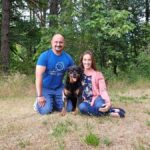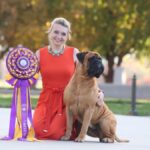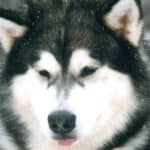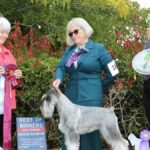The Briard is handsome, alert and powerful without coarseness. He must possess the structural integrity and mental versatility necessary to accomplish his roles as a herding dog used to keep his flock within the boundaries of a designated graze, and an all-purpose farm dog that serves the shepherd in diverse tasks. These roles, which keep him on the move for long hours, demand soundness, efficiency, and athleticism above all other things.
A hands-on examination and evaluation of movement is necessary to determine the details of the breed standard.
Touching the dog to verify what the coat covers is critical to the evaluation of the Briard. Learning to identify the landmarks under the coat will assist the eye in scrutinizing the movement, which can be shrouded by the dense Briard coat.
There is ample range allowed in size, keeping in mind that undersize is a disqualification. Dogs range from 23″-27″ and bitches from 22″-25½”. The dog should appear masculine and the bitch feminine, irrespective of size. It is perfectly possible that there will be dogs in the ring that are smaller than bitches. The acceptable size range allows for dogs that might be shorter in height than bitches, yet are well within standard height.
Briard proportion can create some visual confusion, primarily due to the illusion the coat can create. The measuring points are clearly defined by the standard. The Briard is equal to or slightly longer than its height at the withers, measured from the point of shoulder to point of buttock. Bitches may be a little longer, which is not a mandate, but rather, a possibility. The word “slightly” is defined as “very small in size, degree, amount or importance.” When explaining the significance of “slightly” in the breed, we often say that if one were to be at the edge of the Grand Canyon, and you were asked to step forward—slightly—how far forward would you go? It is, indeed, a very small measurement. This image clarifies the nuance of the word.
Being a coated and tailed breed that calls for a “moderately advanced breastbone,” the Briard will appear off-square. As specifically stated in the AKC standard, “The Briard is not cobby in build.” It is believed that the word “cobby” was used in its literal sense, per its definition: “Cobby, as that of a Cobb horse, small, usually of stout build,” referring to a type of body and not to describe the length of back as the word is often used in the dog world today. The “cobby” image calls to mind a Briard that is heavy and inelegant, like that of a draft horse.
The withers are prominent, the back straight, the loin broad, with croup slightly sloped. The ribs are moderately curved in an inverted egg shape. The correlation between the depth of chest, breastbone, and ribcage are important as they enhance the correct shape of the dog, but most importantly of all, they provide a body shape that promotes lung and heart capacity, essential to the ability to work a full day with endurance and resistance to fatigue.
A Briard head gives the impression of length and sufficient width, its length being about forty percent of the height of the dog at the withers. Skull and muzzle are of equal length, strong, and cleanly sculptured with the planes of the head being parallel. The occiput is surprisingly prominent. The nose is square and must be black, no matter the color of the dog. Ears are to be set high, and may be either cropped or left natural. There is no preference given to either, but the ears should be expressive and mobile—though they will not necessarily be in a constant state of alert. The eyes are set well apart, large, neither round nor almond, with a horizontal axis, and the upper lid is somewhat arched. They are black or black-brown, with a confident, questioning expression. Pigmentation of the eye rims should be very dark, sometimes extending beyond the rim of the eye. The lips are black.
The neck is of good length and is in the shape of a truncated cone. “The head joins the neck in a right angle and is held proudly alert” is a phrase that is applied to the dog in a stationery position. It connotes the manner in which the neck joins the base of the skull. It does not imply that the neck is held in a vertical line. When in motion, the head and neck should extend forward.
The outline of the Briard is completed by a breed hallmark, the distinctive tail that ends in a crook (or “crochet”), similar to the letter “J” when viewed from the right side of the dog. The shape is not always apparent when the dog is in repose. Ideally, the tail should be carried low, never coming above the level of the back (except for the terminal crook).
Another traditional breed hallmark are the double dewclaws required on each rear leg. It is important to learn how to examine for the digits as, ideally, the dewclaws form functional toes and are, therefore, much lower than one might anticipate.
The Briard coat should enhance the outline of the dog. A correct coat needs less grooming and functions better in the elements. The correct double coat is coarse, hard and dry, and slightly waving on the outside with a tight, short, protective undercoat. The colors are black, tawny, and gray in various shades. Combinations of two of these colors are permitted without marked spots, but rather, with smooth, gradual, and symmetrical transitions from one color to another. White is not allowed, except as scattered white hairs throughout the coat on all colors or as a spot on the chest no bigger than one inch in diameter at the root of the hairs. Briards may go through color changes from puppyhood to adulthood, which may include the changing of some black coats to gray, and tawny coats to lighten (and then darken) over time. This transitional color change also occurs in the grays. The coat texture may also go through changes over the course of several years.
The gait of the well-conformed Briard is beautiful to behold. It is light and gliding, a marvel of supple power; effortless. It is important that the angulations of the front and rear be correct and equal, to help drive the dog forward and create the balanced gait so valued by the shepherd. Briard movement clearly displays the balance, power, flexibility, and soundness synonymous with its correct structure.
DISQUALIFICATIONS
- All dogs or bitches under the minimum size limits
(dogs under 23″ and bitches under 22″)
- Yellow eyes or spotted eyes
- Nose any color other than black
- Tail non-existent or cut
- Less than two dewclaws on each rear leg
- White coat
- Spotted coat
- White spot on chest exceeding 1″ in diameter
The BCA’s Breed Education Booklet that contains the breed standard and commentary is available on the Briard Club of
America’s website.
AUTHORS
Marsha Clamp, Theresa Lee, Terry Miller, Margaret Shappard, Denise Simenauer, and Meg Weitz
EXAMINING THE BRIARD
The Briard should be approached calmly, with assurance and self-confidence on the part of the examiner. The Briard should stand his ground without cringing or menacing the examiner. All judges are expected to check for each of the Briard’s disqualifications. If a Briard does not appear to meet the minimum height requirement for its sex, it is incumbent upon the judge to request a wicket and measure the dog. Bearing in mind that the head is coated, approach from the front so the dog can see you and be aware of your presence. Place one hand under the chin, taking care to not grab the beard. Head planes, proportions, and ear placement are confirmed during this portion of the exam. Brush the hair away from the eyes to check eye color, shape, placement, and pigmentation. You may then move on to examining the bite and noting nose color. Any disqualifications on the head may be identified at this time.
To check for disqualifying white on the chest, face the same direction as the dog, place your right hand on the left side of the dog’s head as you lean forward to lift the coat on the dog’s chest. Do make sure the dog’s head is controlled by the handler. It is recommended that you follow good judging practice as directed by the AKC to avoid placing yourself at risk. Proceed with the examination as with any other breed. Remember to check for coat quality as you examine the body. To examine for length of tail, continue from your exam of the loin and croup, gently place your hand at the base of the tail, then run it down to the bony tip of the tail, verifying that it is uncut. You may then bring the tail over to the hock, taking care not to pull, stretch or force the crook of the tail open to make your determination of length.
You must be able to confirm that there are two dewclaws on each rear leg. When reaching down to check for dewclaws, do not use the dog’s hindquarters to support yourself; nor should you stoop down or kneel on the ground. To facilitate the examination of the dewclaws, place your hand at ground level at the inside of each rear foot and move it upward. Dewclaws that are attached low on the leg or are positioned next to the other toes may necessitate that you lift the foot to confirm the presence of the dewclaws. If you are unable to locate the dewclaws, give the handler the option of showing them to you. If the handler wishes you to proceed with the exam yourself, carefully lift the leg back and up just a bit, keeping the foot and leg in line with the body.







